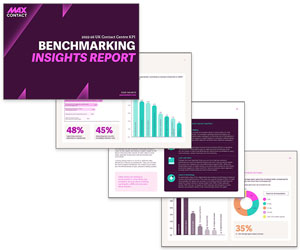For decades, IVRs (interactive voice response systems) and ACDs (automatic call distributors) have been the gatekeepers of the contact centre experience – functional, but often impersonal and inflexible. After all, they were built to handle volume, not to understand nuance.
But now, the way customers engage with businesses is shifting – fast.
AI is changing the entire entry point into the contact centre, rerouting what used to be phone-based journeys into fluid, omnichannel interactions. And it’s not just about automation for efficiency’s sake – it’s about making things feel more human, more intelligent, and more immediate.
So, are IVRs and ACDs still relevant? Or are they quietly being phased out as AI takes the lead?
Let’s dig into what’s really going on.
IVRs – the Old-School Gatekeeper
Interactive voice response (IVR) systems have traditionally been the first line of defence in contact centres. They’re the ones that greet callers with menus like “Press 1 for billing, 2 for support,” and so on.
When they work well, they efficiently direct customers to the correct department, avoid unnecessary live-agent time, and keep things consistent.
But when they don’t? You get stuck in “IVR hell”.
- Complex menus that confuse more than help.
- Lack of nuance – as customers can’t express themselves in natural language.
- Disjointed experiences when the system fails to interpret intentions.
- Punching in five options just to reach a real person, only to realize you’re stuck in a loop? Or worse, been prompted for information you’ve already provided.
For the key do’s and don’ts when redesigning and implementing your IVR system, read our article: Mastering IVR – What to Do and Avoid
ACDs – the Rigid Rule-Follower
Automatic call distributors (ACDs) take those incoming calls and route them to agents based on rules: department, skill set, queue length. They’re clever in their own way – speeding up distribution, balancing workloads, even prioritizing VIPs.
But again, they have their limits:
- They rely on rigid rule sets and predefined conditions.
- They can’t figure out intent beyond the box they’ve been given.
- They don’t learn or adapt in real time.
- Customers still end up waiting in queues if volumes surge.
That being said, when IVRs and ACDs are integrated, they offer a good flow: callers get wrangled into groups by IVR then handed off to the right agent group. But there’s not much room for nuance, no flexibility.
And now that AI is here, in all its glory – filled to the brim with new features and expertly adept at “the in-between” and the grey area – where does that leave them?
AI-Powered Chatbots and AI Agents Are Increasingly the First Stop
AI-powered chatbots and AI agents are increasingly the first stop these days, not the phone line – as seen in the latest Call Centre Helper annual report, which showed a dip below 50% in inbound voice for the first time in 2025:

Many customers start with a digital chat on a website or app, designed to determine the specific caller intent.
If the chatbot can’t resolve the issue, it escalates to a voice call, avoiding the IVR/ACD steps altogether. The customer is handed straight to a live agent if needed, without wading through menus or queues.
This shift is doing two important things:
- Reducing call volume, because many simple queries get resolved digitally.
- Bypassing IVR/ACD systems, making them less essential.
So, companies still running IVRs and ACDs are seeing less traffic through them.
As AI use rises, do these the old systems weigh heavier in the contact‑centre tech stack – underutilized and increasingly obsolete?
AI Bots Don’t Just Escalate – They Handle Many Enquiries End-to-End
AI bots don’t just escalate, they handle many enquiries end-to-end. They’re trained to answer FAQs, guide trouble‑shooting, and even carry out straightforward transactions. This deflects volume away from live calls, meaning fewer interactions need passing through IVRs and ACDs.
That deflection is pivotal. When fewer people call, less volume enters ACD queues. Even if you still run those systems, they’re gradually underused and unnecessary.
Organizations find they can simplify their infrastructure, reduce costs, and focus on the smart routing layer that matters most.
Is AI-Driven Routing Simply the Upgraded IVR/ACD Combo?
You could say AI-driven routing is the upgraded IVR/ACD combo – but smarter. Instead of customers pressing numbers or waiting in queues, the system listens, understands, and directs them dynamically.
The benefits of AI routing include that it:
- Interprets intent from voice or chat.
- Routes callers (or users) to the best agent based on skill, availability, and context.
- Adapts in real time to changing demand or staffing.
- Offers analytics that reveal bottlenecks and help train agents.
So, while the principles of IVR/ACD (collect intent, and route to the best resource) remain, the implementation is evolving from rigid menu systems to intuitive AI flows that vary according to need.
Voice Assistants in Action (a Simplyhealth Case Study)
At Simplyhealth, they’ve deployed three intent-led digital voice assistants, each with a trained script for specific FAQs, and even made their assistant sound human.
In collaboration with Poly AI, Simplyhealth now resolves approximately 30% of their total call volumes without human intervention.
They currently have three voice assistants in place speaking directly to customers – all trained on a specific set of FAQs to handle and resolve different types of queries.
The assistant greets you with “How can I help you?” and starts to triage calls right away, without long queues. It even ends conversations with “Thanks and enjoy the rest of your day”, and plays subtle typing noises to mimic realism.
Amy Elliott, Digital Service Manager, notes:
“Deploying this technology has been one of the most transformative things we’ve ever done – particularly as we initially rolled it out in a part of the business that experienced the highest volume of calls.”
There is one important caveat to this approach: vulnerable customers. AI, in integration with CRM data, routes vulnerable customers straight to a human agent – as Dan Eddie, Director of Customer Service, emphasizes, “It’s all about knowing who your customers are!”
So, in this example, voice assistants:
- Handle a significant portion of volume.
- Eliminate redundant IVR menus and queue waiting.
- Make the experience feel natural and friendly.
- Respect the unique needs of vulnerable customers by fast‑tracking them to human help.
AI Is Reshaping the Entire Contact Centre Entry and Routing Model
In short, AI isn’t just enhancing IVRs and ACDs – it’s reshaping the entire contact‑centre entry and routing model.
So, are IVRs and ACDs being displaced? The short answer is yes, increasingly so.
As Paul Weald, the Contact Centre Innovator, notes, this shift should be a conscious decision, so that you don’t give the customer too many channel choices in how they contact you:

“Gartner research shows that resolution rate and CSAT actually go down when you give the user too much choice. The reason for this is the psychology of the choice paradox – identified by Barry Schwartz in 2004 – where giving users too many options to consider produces paralysis rather than action.
Applying this logic to customer journey management means giving the user a choice of only three options and then guiding them towards a preferred option as the best approach for enquiry routing”.
IVRs and ACDs Are No Longer as Necessary as They Once Were
From chatbots interacting naturally, to voice assistants handling one‑third of calls, these tech layers deflect enquiry load, cut wait times, and deliver more personal experiences.
IVRs and ACDs are being displaced not because they’re bad, but because they’re no longer as necessary as they once were. And as these solutions evolve, so we can expect to see these old school solutions being retired from operational use.
The smarter, more dynamic world has arrived, and for many, that means goodbye to menus and switchboard delays – and hello to conversational AI.
For more information on AI in the contact centre, read these articles next:
- What’s Next for Voice of the Customer (VoC)?
- 10 New Ways Tech Is Helping Agents Right Now
- What Are Intelligent Contact Centres Doing Right Now?
Author: Stephanie Lennox
Reviewed by: Xander Freeman
Published On: 7th Oct 2025 - Last modified: 14th Oct 2025
Read more about - Technology, Artificial Intelligence (AI), Automatic Call Distributor (ACD), Dan Eddie, IVR Solutions, Paul Weald, Stephanie Lennox, Top Story





















